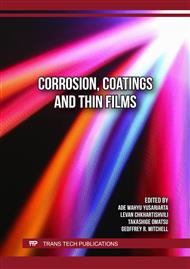[1]
L. B. Coelho et al., "Mechanical and corrosion characterization of industrially treated 316L stainless steel surfaces," Surf. Coatings Technol., vol. 382, p.125175, 2020.
DOI: 10.1016/j.surfcoat.2019.125175
Google Scholar
[2]
Z. ur Rahman, K. M. Deen, L. Cano, and W. Haider, "The effects of parametric changes in electropolishing process on surface properties of 316L stainless steel," Appl. Surf. Sci., vol. 410, p.432–444, Jul. 2017.
DOI: 10.1016/j.apsusc.2017.03.081
Google Scholar
[3]
K. Rokosz, T. Hryniewicz, S. Rzadkiewic, and S. Raaen, "Elektrolitičko poliranje nehrđajućeg čelika AISI 316L (EN 1.4404) uz visoku gustoću struje (HDEP)," Teh. Vjesn., vol. 22, no. 2, p.415–424, 2015.
DOI: 10.17559/TV-20140722110711
Google Scholar
[4]
C. C. Lin, C. C. Hu, and T. C. Lee, "Electropolishing of 304 stainless steel: Interactive effects of glycerol content, bath temperature, and current density on surface roughness and morphology," Surf. Coatings Technol., vol. 204, no. 4, p.448–454, 2009.
DOI: 10.1016/j.surfcoat.2009.08.005
Google Scholar
[5]
A. Raval, A. Choubey, C. Engineer, and D. Kothwala, "Surface conditioning of 316LVM slotted tube cardiovascular stents," J. Biomater. Appl., vol. 19, no. 3, p.197–213, 2005.
DOI: 10.1177/0885328205046564
Google Scholar
[6]
J. R. (Joseph R. . Davis and ASM International. Handbook Committee., Stainless steels. ASM International, 1994.
Google Scholar
[7]
W. D. Callister and D. G. Rethwisch, "Materials Science and Engineering: An Introduction", 10th ed., Hoboken, NJ: John Wiley & Sons, 2018..
Google Scholar
[8]
S. A. Kukushkin, V. I. Blinov, and A. V. Osipov, "Microstructure and Corrosion Resistance of Ferritic and Martensitic Stainless Steels: A Review," Materials, 2019.
Google Scholar
[9]
Outokumpu, "Handbook of Stainless steel," p.1–89, 2013.
Google Scholar
[10]
E. Łyczkowska-Widłak, P. Lochyński, and G. Nawrat, "Electrochemical polishing of austenitic stainless steels," Materials (Basel)., vol. 13, no. 11, p.1–25, 2020.
DOI: 10.3390/ma13112557
Google Scholar
[11]
A. Latifi, M. Imani, M. T. Khorasani, and M. D. Joupari, "Electrochemical and chemical methods for improving surface characteristics of 316L stainless steel for biomedical applications," Surf. Coatings Technol., vol. 221, p.1–12, 2013.
DOI: 10.1016/j.surfcoat.2013.01.020
Google Scholar
[12]
S. N. Kane, A. Mishra, and A. K. Dutta, "Preface: International Conference on Recent Trends in Physics (ICRTP 2016)," J. Phys. Conf. Ser., vol. 755, no. 1, 2016.
DOI: 10.1088/1742-6596/755/1/011001
Google Scholar
[13]
A. Q. A. Teo, L. Yan, A. Chaudhari, and G. K. O'neill, "Post-processing and surface characterization of additively manufactured stainless steel 316l lattice: implications for biomedical use," Materials (Basel)., vol. 14, no. 6, p.1–23, 2021.
DOI: 10.3390/ma14061376
Google Scholar
[14]
E. Lyczkowska-Widlak, P. Lochynski, G. Nawrat, and E. Chlebus, "Comparison of electropolished 316L steel samples manufactured by SLM and traditional technology," Rapid Prototyp. J., vol. 25, no. 3, p.566–580, 2019.
DOI: 10.1108/RPJ-03-2018-0060
Google Scholar
[15]
W. Han and F. Fang, "Eco-friendly NaCl-based electrolyte for electropolishing 316L stainless steel," J. Manuf. Process., vol. 58, no. September, p.1257–1269, 2020.
DOI: 10.1016/j.jmapro.2020.09.036
Google Scholar
[16]
"Surface Texture ( Surface Roughness , Waviness , and Lay )," vol. 2009, 2009.
Google Scholar
[17]
A. Bpe-, "Bioprocessing Equipment Bioprocessing Equipment," vol. 2016, 2016.
Google Scholar
[18]
P.J. Núñez, E. García-plaza, M. Hernando, and R. Trujillo, "Characterization of Surface Finish of Electropolished Stainless steel AISI 316L with Varying Electrolyte Concentrations," Procedia Eng., vol. 63, p.771–778, 2013.
DOI: 10.1016/j.proeng.2013.08.255
Google Scholar
[19]
P. Pendyala, M.S. Bobji, and G. Madras, "Evolution of surface roughness during electropolishing," Tribol. Lett., vol. 55, no. 1, p.93–101, 2014.
DOI: 10.1007/s11249-014-0336-x
Google Scholar
[20]
H. Hocheng, P.S. Kao, and Y.F. Chen, "Electropolishing of 316L Stainless steel for Anticorrosion Passivation," vol. 10, no. August, p.414–418, 2001.
DOI: 10.1361/105994901770344827
Google Scholar
[21]
S. J. Lee and J. J. Lai, "The effects of electropolishing (EP) process parameters on corrosion resistance of 316L stainless steel," J. Mater. Process. Technol., vol. 140, no. 1-3 SPEC., p.206–210, 2003.
DOI: 10.1016/S0924-0136(03)00785-4
Google Scholar
[22]
P. Barnes et al., "Electropolishing valve metals with a sulfuric acid-methanol electrolyte at low temperature," Surf. Coatings Technol., vol. 347, no. 2017, p.150–156, 2018.
DOI: 10.1016/j.surfcoat.2018.04.082
Google Scholar
[23]
B. Chatterjee, "Science and industry of electropolishing [Part 2)," Galvanotechnik, vol. 110, no. 2, p.255–262, 2019.
Google Scholar
[24]
G. Yang, B. Wang, K. Tawfiq, H. Wei, S. Zhou, and G. Chen, "Electropolishing of surfaces: theory and applications," Surf. Eng., vol. 33, no. 2, p.149–166, 2017.
DOI: 10.1080/02670844.2016.1198452
Google Scholar
[25]
E. S. Lee, "Machining characteristics of the electropolishing of stainless steel (STS316L)," Int. J. Adv. Manuf. Technol., vol. 16, no. 8, p.591–599, 2000.
DOI: 10.1007/s001700070049
Google Scholar
[26]
S. Habibzadeh, L. Li, D. Shum-Tim, E. C. Davis, and S. Omanovic, "Electrochemical polishing as a 316L stainless steel surface treatment method: Towards the improvement of biocompatibility," Corros. Sci., vol. 87, p.89–100, 2014.
DOI: 10.1016/j.corsci.2014.06.010
Google Scholar
[27]
S. Parker, Principles and Practice, vol. 32, no. 3. 2006.
DOI: 10.1177/0340035206070163
Google Scholar
[28]
W. Han and F. Fang, "Fundamental aspects and recent developments in electropolishing," International Journal of Machine Tools and Manufacture, vol. 139. Elsevier Ltd, p.1–23, Apr. 2019.
DOI: 10.1016/j.ijmachtools.2019.01.001
Google Scholar
[29]
A. M. Awad, E. A. Ghazy, S. A. Abo El-Enin, and M. G. Mahmoud, "Electropolishing of AISI-304 stainless steel for protection against SRB biofilm," Surf. Coatings Technol., vol. 206, no. 14, p.3165–3172, 2012.
DOI: 10.1016/j.surfcoat.2011.11.046
Google Scholar
[30]
W.A.F. Base, "VoL. 2, No. 5, October, 1963," vol. 2, no. 5, p.1–2, 1963.
Google Scholar
[31]
V. Sülar and A. Okur, "New application of a surface roughness tester on fabrics," AATCC Rev., vol. 7, no. 9, p.39–43, 2007.
Google Scholar
[32]
C. A. I. Handbook, "ASM Metals Handbook, Volume 09 Metallography and Microstrustures Handbook," ASM Int., vol. 9, p.2733, 2004.
Google Scholar
[33]
M. Ikhsan Almadani, R. Siswanto, and P. Studi Teknik Mesin, "Proses Manufaktur Mesin Poles Dan Ampelas Untuk Proses Metalografi," vol. 2, 2020.
DOI: 10.20527/jtam_rotary.v2i1.2001
Google Scholar
[34]
M. Moshinsky, "No Title," Nucl. Phys., vol. 13, no. 1, p.104–116, 1959.
Google Scholar
[35]
A. Cahyana and A. Marzuki, "Analisa SEM (Scanning Electron Microscope) pada Kaca TZN yang dikristalkan Sebagian," Pros. Math. Sci. Forum 2014, p.23–26, 2014.
Google Scholar
[36]
Pierre R. Roberge, Handbook of Corrosion Engineering Library of Congress. 1999.
Google Scholar


